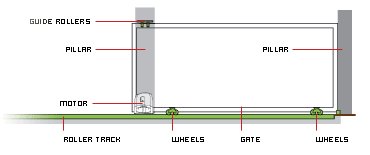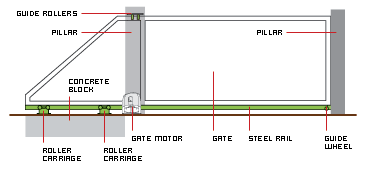Sliding Gates
Sliding gates offer a great alternative to swing gates. Perhaps you prefer sliding gates, or more likely the layout of your property demands a sliding gate as an alternative.

You will almost certainly need a sliding gate if your entrance way:
- Has limited room for swing gate wings to open in, compromising possible parking space.
- Turns sharply left or right and a swinging gate would create an obstruction to the turning vehicle.
- Is on a steep upward incline preventing a swing gate wing from opening up the drive.
Sliding gate designs can replicate those of swinging gates, giving the illusion of being a pair when closed.
They can be made to the same standard designs and from the same materials as swing gates.
Sliding gates do offer you the advantage of being able to fit where a traditional swing gate wouldn't, offering you nearly the same aesthetic and security advantages. Indeed a sliding gate is often more secure once locked as the gates weak points are usually less accessible and the single structure design ensures additional prevention from the gate being driven into.
There are two different types of sliding gate mechanism:
- The traditional roller-tracked sliding gate

- The cantilever sliding gate

A tracked sliding gate runs on wheels along a grooved steel rail that is buried just below ground level.
A cantilever gate is counterbalanced above the ground, supported by rollers fitted to the bottom of the gate. The advantage of a cantilever gate is that you don't have to keep the track free of leaves - however, cantilever gates are generally more expensive as they require more civil engineering.
Both roller-tracked AND cantilever gates can be automated using any of the CAME range of sliding gate motors.
